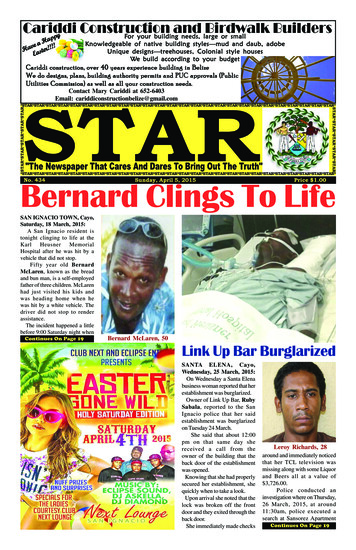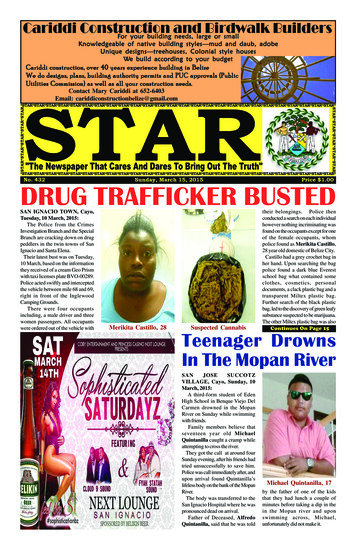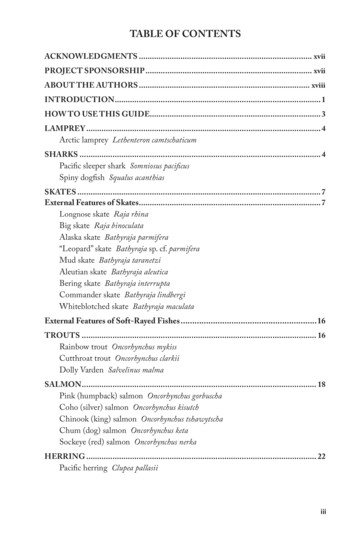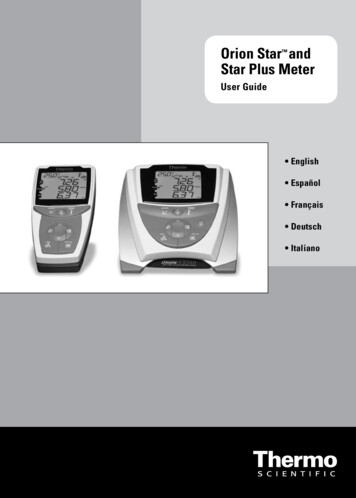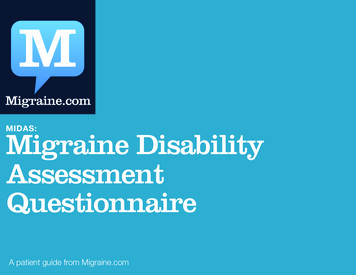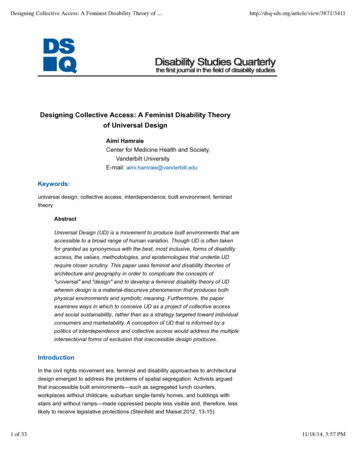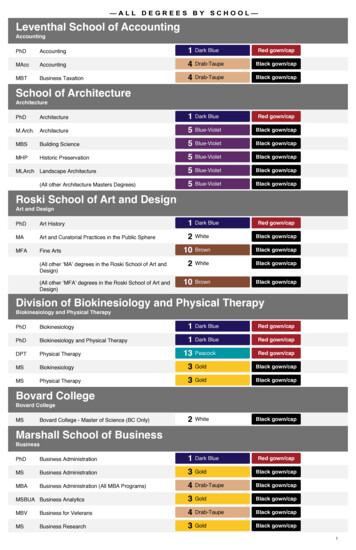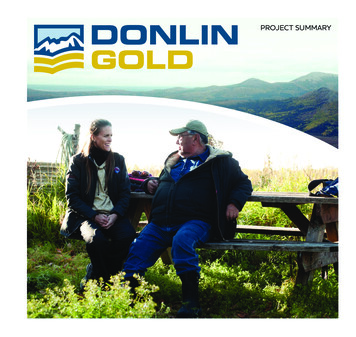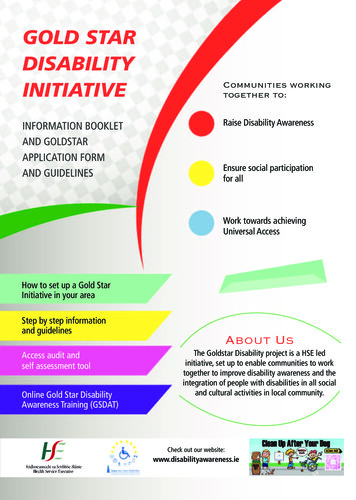
Transcription
GOLD STARDISABILITYINITIATIVEINFORMATION BOOKLETAND GOLDSTARAPPLICATION FORMAND GUIDELINESCommunities workingtogether to:Raise Disability AwarenessEnsure social participationfor allWork towards achievingUniversal AccessHow to set up a Gold StarInitiative in your areaStep by step informationand guidelinesAccess audit andself assessment toolOnline Gold Star DisabilityAwareness Training (GSDAT)About UsThe Goldstar Disability project is a HSE ledinitiative, set up to enable communities to worktogether to improve disability awareness and theintegration of people with disabilities in all socialand cultural activities in local community.Check out our website:www.disabilityawareness.ie
INTRODUCTIONThe original Gold Star universal access initiative commenced inCashel, Co. Tipperary in 2006. Acknowledging thecomprehensive framework of equality legislation in Ireland, theGold Star Initiative working with the Cashel community chose acommunity development approach to facilitate effective actionand acceptable standards in an effort to ensure people withdisabilities would not be excluded from social, economic andpolitical life.The ‘Gold-Star’ standard award acknowledges agencies,businesses, organisations, community facilities and services thatmake adaptations and take measures to have their buildings,amenities and services made more welcoming and accessible toall people. The ultimate aim of the Gold Star project is topromote greater independence, integration and participation forall people in their local communities.The following Booklet is offered as a generic step by stepguide to assist groups achieve a Gold Star standardaward:I wish groups endeavouring to roll out a Gold Star initiative intheir community every success and I look forward to seeing theinitiative being established and set-up on a nationwide contextinto the future.Anne BradshawHSE, Disability Services,On behalf of the HSE Gold-Star Initiative.2
For further information:www.disabilityawareness.ieThe booklet can be downloaded online at:www.disabilityawareness.ieAccessible versions of the booklet are available on request:anne.bradshaw@hse.ieFollow us on Facebook at: Tipperary Goldstar/Cashel GoldstarNOTE:The Booklet is offered as guideline only. Every effort has beentaken to ensure accuracy but ultimate responsibility to ensurecompliance with current legislation and general accessibilityregulations continues to rest with the individual/organisation.The Task Group recommends that applicants refer to thecurrent planning legislation, Building regulations 2010,Technical Guidance Document Access and Use. These shouldbe read in conjunction with The Building Regulations1997-2010 and/or appropriate agencies prior to commencingadaptations, alterations or construction.See referencing page 193
3 KEY STEP BY STEP GUIDELINES TOWARDS INITIATING AGOLD STAR STATUS PROJECT:1. Consultation:Lead person/agency on Gold Star Initiative undertakes anextensive consultative process with people with disabilities andthe community, identifying needs to be addressed to achieveuniversal access.(Some important key agencies to be engaged for professionaladvice and support include: NCBI, Working for People with SightLoss in Ireland, DeafHear.ie, The Irish Wheelchair Association,(IWA), The Disability Federation of Ireland, (DFI), NationalDisability Authority (NDA) and HSE) This list is for guideline purpose and is not exhaustive.2. Host an open public meetingHost an open public meeting themed “Disability and yourCommunity”. Invite a local agency or business to offer use ofmeeting rooms for the meeting. Issue invite to appropriateagencies in local area to attend. Advertise the meeting in alllocal public outlets and with local media services.2a. Facilitation:Facilitate the meeting in a manner that will gather informationon the issues that will need to be addressed on the Gold StarProject. Record all issues discussed at meeting, particularly thoseidentifing barriers to universal access in the community. Write upa report outlining all of the issues raised.2b. Gold Star Task GroupInvite people in attendance to volunteer to sit and represent4
their agencies on a local Gold Star Task Group that will overseethe roll out of the Gold Star Initiative. Once a Gold Star TaskGroup is established – negotiate terms and conditions – agreeon a timely initial meeting date and venue.3. At 1st Task Group Meeting: Present Findings of theReport and agree on Action PlanAgree a goal orientated action plan for roll out of Gold Starinitiative, addressing the issues identified in the report. Agreeregular meeting dates to coordinate the development of theGold Star award. Establish working criteria that can beimplemented by businesses and agencies in the area so they canapply for and work towards attaining the ‘Gold Star’ standard.Engage with local community groups: For e.g. young people withdisabilities and schools to develop a Gold Star Logo by adaptingthe generic Gold Star logo (page 8)Available on www.disabilityawareness.ieIncorporate a local feature that will easily identify your village,town or city.Work with Local Authority to erect logo signs on all entranceroute to village/town/cityGroups/agencies/businesses applying for Gold Star Awardsmust engage with three elements:Element 1: Engage with the GSDAT (Gold Star DisabilityAwareness Training) – delivered free of charge over two halfdays, GSDAT consists of general disability awareness andcustomer service training. (See Below)5
Element 2: Complete and submit the Registration Form:Use the Gold Star Application Form and Guidelines InformationBooklet available online. (A pre-assessment accessibility option isavailable online at www.disabilityawareness.ie)Element 3: Award Ceremony: Each application will beevaluated, in conjunction with the access audits, premises will beawarded Bronze, Silver or Gold Star in accordance with theirlevel of accessibility. Each applicant will have an opportunity tobuild on the level of the award received, drawing on advice andassistance from the Task Groups Audit committee. The ultimateaim will be towards achieving Gold Star status in the most costeffective manner possible.1. Gold Star Disability Awareness Training (GSDAT)Free of Charge disability awareness training to be offered to allbusinesses/services taking part. (Trainers should include a mix ofpeople with disabilities and specialist agencies providing servicessuch as HSE, NCBI Ireland, DeafHear.ie, DFI for examples)GSDAT training DVD available on line(www.disabilityawareness.ie)General programme content available from Gold Star Project –Contact Anne Bradshaw, HSE Disability Services,Our Lady’s Hospital, Cashel, Co. Tipperary,Email: anne.bradshaw@hse.ieLog on to www.disabilityawareness.ie6
2. Registration for Accessibility AuditA baseline assessment will be carried out by suitably qualified &experienced members of the Task Group. The Gold Star TaskGroup should set up a voluntary team of access auditors(comprised primarily of people with disabilities and reps fromprofessional agencies providing services for people withdisabilities). The Audit Team will provide a Free of chargevoluntary access audit – resulting in/providing the applicant witha list of cost effective solutions and recommendations to helpimprove the level of accessibility of each premises. (Solutions areoften simple and cost neutral – in some situations examples caninclude adapting existing layout on shop floors to include peoplewith disabilities.).3. Award Ceremony:An award ceremony: Following participation on the GSDATprogramme and evaluation/assessment of completed Gold StarApplication form, applicants will be awarded with either aBronze, Silver and Gold Star status. Where bronze or silver areawarded, it should be accompanied with a set of cost effectiverecommendations and solutions to enable an ultimate award ofGold Star Status. This process is a voluntary process whereapplicants will be given as much assistance, information andguidance as is practicably possible by the voluntary team inefforts to ensure villages, towns or cities are accessible andwelcoming to all. However, it is imperative to remember it is avoluntary community based process where ultimateresponsibility for full legislative compliance rests with theindividual/organisation.7
APPLICATION FORMThis is a community Initiative and there is no chargeI wish to apply to the Gold Star Task Group to audit my buildingin pursuit of a Gold Star Accessibility Award:Name: .Address: .Contact Details: .Please complete and return this application request to:.Or apply on line at www.disabilityawareness.ieLogo Template.For logo access contact: anne.bradshaw@hse.ie8
Universal AccessGold Star Status - Application FormApplicant must fulfill their obligations under Part M of theBuilding Regulations 2010 Technical Guidance Document Accessand Use - to be read in conjunction with the Building Regulations1997-2010. At least 5% of total number of parking spaces shouldbe accessible bays for buildings)Further advise guidance can be found at www.universaldesign.ie1. Approach and Entrance to Buildings(a) Are clear markings and signage provided to identify thebuilding from the public footpath?YesNoN/A(b) Are thresholds flush where possible?YesNoN/A(c) Where possible are ramps provided? (Desirable minimumwidth 1500mm, gradient 1:20 and marked accordingly?YesNoN/A(d) Is street furniture limited outside shops/buildings, includingsandwich boards or advertising stock; and placed beyondboundaries of the access route?YesNoN/A9
(e) Is signage placed at a height which will avoid creatinghazard while taking into consideration view point and easeof reading? (use universally accepted symbols & pictogram)YesNoN/A(f) Are door widths at main entrance, internally and existsaccessible? (Desirable 900mm).YesNoN/A(g) Are intercom systems accessible/visual?YesNoN/A(h) Are doorways and door handles easy to locate/identify?YesNoN/A(i) Are glass doors highly visible by bold bands of contrastingcolour at two levels?YesNoN/A(j) Do doors that open outwards onto circulation paths avoidcreating a hazard?YesNoN/A(k) Do internal doors open inwards from circulation paths?YesNoN/A(l) Is there tactile warning provided at approach to automaticdoors?YesNoN/A(m)Is it ensured that doors are either fully open or fully closed?YesNoN/A10
(n) Do automatic swing/sliding doors have guard rails, pushor kick plate, horizontal or vertical sensing device withclear signage and does the door remain fully open untilarea is cleared by user?YesNoN/A(o) Is the entrance well illuminated with even lighting betweenentrance and reception area?YesNoN/ASee compliance requirements for stairs in parts B, K and Mof building regulations2. Steps, stairs and slopes/ramps(a) Is an appropriate tactile warning surface provided inadvance of stairs/steps to warn of the change of level?YesNoN/A(b) Are leading edges/nosings of all steps clearly marked incontrasting tone?YesNoN/A(c) Do stair markings run the entire width of the step and arethey 50 to 75mm wide on both threads (‘floor’ of step) andrisers (upright part of step)?YesNoN/A(d) Is headroom on the underside of stairs or escalators less than2200mm, and if so, is this area guarded to eliminate hazard?YesNoN/A11
(e) Are single or isolated steps highlighted/photo luminescent?(Single steps best avoided where possible)YesNoN/A(f) Where ramps are provided, (desirable minimum width1500mm, gradient 1:20), are there associated steppedapproaches with handrails?.(Ref. Part M of the Building Regulations)YesNoN/A(g) Are handrails provided on both sides of the stairs or ramp?(Handrails should extend beyond the first and last step to aminimum of 300mm).YesNoN/A(h) Do handrails follow the exact contour of the stairs in orderto provide directional guidance?YesNoN/A3. Lifts(a) Is the lift conveniently located in relation to the lobby withclear signage?YesNoN/A(b) Has the lift door a clear opening width of at least 800mm?YesNoN/A(c) Do lift buttons have Braille as well as raised tactile numbersor letters?YesNoN/A12
(d) Are audible announcements as well as visual signs used toidentify which floor has been reached, if serving more than 3floors?YesNoN/A(e) Are lift doors fitted with an adequate time delay mechanism?YesNoN/A(f) Is the lift car well illuminated with the lighting level constantwith lobby area?YesNoN/A(g) Is there a mirror on the back wall of the lift to providewheelchair users with a rear view to safety reverse out fromthe liftcar?YesNoN/A(h) Is there clear policy/guidelines for Health & Safety evacuationin the event of fire?YesNoN/ACorridors, passageways and internal lobbies should facilitate freeflow and be at least 1200mm width4. Premises and Circulation Areas(a) Are reception or cash desks strategically placed and easilyidentifiable by their general surroundings with clear signage?YesNoN/A(b) Are mats and other loose floor coverings avoided?YesNoN/A13
(c) Are lighting levels throughout the building during the dayand at night relatively constant?YesNoN/A(d) Are internal circulation ways in shops/building adequate forall people to access goods?YesNoN/A(e) Is there a loop system to facilitate people with hearingimpairments with staff trained in using the system and isthe correct signage in place?YesNoN/A(f) Are printed information materials user friendly forcustomers? (example large print, simple language andpictogram)YesNoN/A(g) Is there a split level counter to allow for universal access?(this can be a small section (Desirable Height 750-850mm)YesNoN/A(h) Do supermarkets provide a number of wheelchair accessibletrolleys?YesNoN/A(i) Do shops provide staff assistance for people who requireassistance when shopping?YesNoN/A(j) Is there matt-finished rather than shiny surfaces wherepossible to help to prevent glare?YesNoN/A14
(k) Are contrasting colours or tones used to highlight furniture,fixtures and hazards?YesNoN/A(l) Are glass panels, mirrors etc., clearly marked to avoidhazard, confusion or disorientation?YesNoN/A(m)Are staff aware that to get the attention of people whoare deaf or hard of hearing they must: face the person, makeeye contact, speak slowly using facial expression andgestures to help with communication?YesNoN/A(n) Are staff aware that literacy can sometimes be a problem forsome people in the community and should use simple,concise writing style?YesNoN/A(o) Are staff aware they must avoid standing in front of a lightsource when communicating with people who are Deaf/hardof hearing?YesNoN/A(p) Is seating easily accessible, in a permanent position and notobstructing the main circulation area?YesNoN/A15
(q) Is the use of low level tables (below knee height) avoided?YesNoN/A(r) Does management ensure all staff are aware that GuideDogs must be admitted to all venues with their owners?YesNoN/A(s) Is the carpet pile suitable for wheelchair users to push chairsindependently?YesNoN/A(t) The development of a building evacuation plan is essentialto the safe evacuation of all people in emergencies. Hasmanagement an Egress policy and an evacuation actionplan developed?YesNoN/A5. Toilet Facilities(a) Is size and literacy appropriate signage used to indicatelocation of toilets?YesNoN/A(b) Does the design of toilet facilities incorporate ease of usefor all people?YesNoN/A16
(c) Are wheelchair accessible toilets compliant with Part M ofBuilding Regulations 2000? (Accessible toilets, larger thanthe minimum size in Part M are desirable)YesNoN/A(d) Are hot and cold water taps identifiable by both colour andtactile markings?YesNoN/A(e) Does the sanitary ware contrast well with surrounding walland floors?YesNoN/A(f) Where facilities are provided, such as buttons on the floor ortaps which operate by use of sensors, is there accessiblesignage which explains this?YesNoN/A6. B&B, Guesthouses and Hotels(a) Is there one guest bedroom out of every 20 suitable in size,layout and facilities for independent use by a wheelchairuser?YesNoN/A(b) Does the entrance door to an accessible guest bedroomcomply with Part M of the building regulations 2010?YesNoN/A17
(c) Is there ensuite accessible sanitary accommodation?YesNoN/A7. General(a) Has the applicant nominated at least one member of staff toto participate on the Gold Star Disability Awareness Training(GSDAT) programme?YesNoN/A(b) Has the applicant displayed a GSDAT certificate ofattendance on their premises in a public area?YesNoN/A(c) Has management committed to staff attending on-goingrefresher disability awareness when necessary?YesNoN/A(d) Has Management invited customers with disabilities tomake suggestions in terms of improving service provision?YesNoN/A(e) Has Management committed to reviewing work practices toensure full inclusion of people with disabilities wherepossible?YesNoN/A18
(f) Has Management committed to encouraging people withdisabilities to apply for jobs advertised?YesNoN/A(g) Where other barriers to participation exist during the accessaudit which have not been identified in the above list, willmanagement commit to addressing them in consultationwith professionals agencies and those conducting the DeafHear.iewww.nda.ieBuilding for everyone- A universal design approach (2010 Edition),National Disability Authority, 25 Clyde Road, Ballsbridge, D4Legislation: Disability Act 2005, Equal Status Act 2000-2008, Employment Equality Acts 1988 and 2004 Building Control Act, 2007 Building Regulations 1997-2010 Safety, Health & Welfare at Work (General Application) Building Regulations (2010), Technical Guidance DocumentsPart M, Dept of Environment, Heritage and Local Government. Best practice Guidelines Designing Accessible Environments,Irish Wheelchair Association, Áras Chúchulainn,BlackheathDrive, Clontarf D.3 www.iwa.ie19
APPLICATION FOR GOLD STAR STATUS(This is a community based initiative which is a free ofcharge process.)Summary of Guidelines and Application Criteria:All applicants must make their application to theGold Star Task Group. A set of guidelines have been drawn upfollowing extensive consultation with members of the localcommunity, disability groups, private, public, voluntary andcommunity agencies in the area.1. All applicants make applications to Gold Star Task Group.2. Task Group voluntary committee will evaluate and assessapplications3. A baseline assessment and audit will be carried out bysuitably qualified and experienced members of the TaskGroup, where other appropriate bodies/agencies will beinvited to participate in the assessment.4. Award recommendations will be made, ranging from Bronze,Silver and GoldGold 85% score or moreSilver 70 - 84%Bronze 60 - 69%20
5. Task Group to decide on number of businesses/services/groupsratio necessary to achieve an overall village/town/city GoldStar Award.6. The overall award for village/town/city should be made on aonce off basis for a renewable period of time. (18 months)7. Awards should be monitored by Task Group over time toensure standard maintenance8. At all times it must be noted that the Gold Star Award systemis a community based initiative where levels of acceptableaccessibility are agreed and set down by local communitypeople. Ultimate responsibility for full compliance withlegislative requirements rests with individual applicants at alltimes.The process is a voluntary process where applicants will be givenas much assistance, information and guidance as possible by thelocal Task group. Ultimate responsibility remains on the applicantto ensure full legal compliance with government policy andlegislation. We accept no responsibility for individual/agenciesservice provision.Online Disability Awareness Trainingwww.disabilityawareness.ie21
22
23
DO’S AND DONT’S OF DISABILITYTheGold Star initiative is about everybody workingtogether in the Community to improve disability awareness and tomake sure villages, towns and cities are accessible and welcoming toall.1.When talking to a person using a wheelchair for more than a fewminutes, it’s good to use a chair to make sure you are at the sameeye level as them.2.Look and speak directly to a person with a disability-rather thanlooking at or speaking through a friend they may have with them.3.It’s okay to ask people with disabilities what you can do to helpthem.4.Try to find a good way to communicate with a person who is deaf orhas hearing loss - they may lip-read, sign or write down what theywant.5.Don’t feel you should shout at or speak slower to a person with adisability.6.When greeting a person who is blind or has visual impairments,always introduce yourself and if they have a guide dog with them,always ask if it’s okay before you rub or touch him.7.It’s best to NEVER!! Park on footpaths.even if it’s only for‘2 minutes’ and best to NEVER use accessible parking bays withouthaving a parking permit displayed.General programme content available from Gold Star ProjectContact Anne BradshawHSE Disability Services, Our Lady’s Hospital, Cashel, Co. TipperaryEmail: anne.bradshaw@hse.ieLog on to www.disabilityawareness.ie
apply for and work towards attaining the 'Gold Star' standard. Engage with local community groups: For e.g. young people with disabilities and schools to develop a Gold Star Logo by adapting the generic Gold Star logo (page 8) Available on www.disabilityawareness.ie Incorporate a local feature that will easily identify your village, town or .
